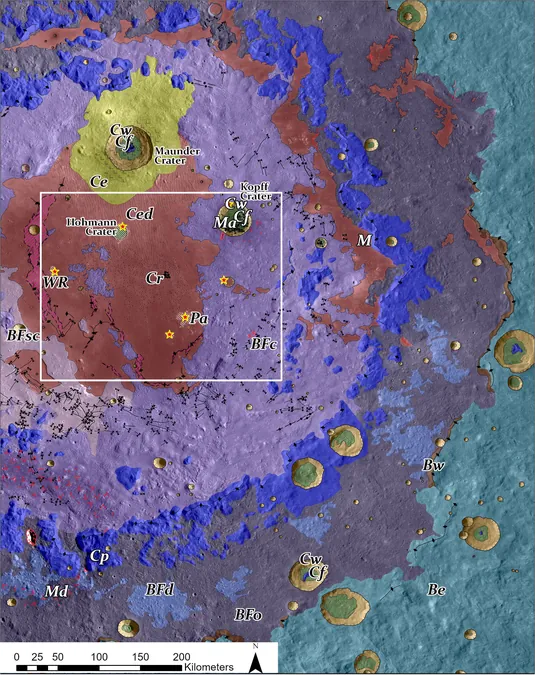
Revolutionary Lunar Map Paves the Way for Future Sample Return Missions!
2024-11-18
Author: Emma
A Groundbreaking New Study
A groundbreaking new study reveals a meticulously crafted high-resolution geologic map of the Orientale basin on the moon, designed to guide future sample return missions. The Orientale basin, formed billions of years ago by a colossal asteroid impact, retains crucial information about the early history of our solar system.
The Impact of the Asteroid
When the asteroid struck, it generated extreme heat that melted the lunar rock, creating what scientists term “impact melt.” This molten material eventually cooled and solidified, resulting in the distinctive multi-ringed crater visible today. However, much of this original impact melt has been obscured by subsequent geological activity, including lava flows and smaller asteroid impacts.
Importance of Obtaining Samples
Obtaining samples of this impact melt is critical for researchers aiming to date such cataclysmic events. Understanding the timing of these impacts helps scientists decipher the history of impacts not just on the moon but also on Earth, offering insights into how these cosmic events may have influenced the development of life on our planet.
Expert Insights
Lead author Kirby Runyon, a research scientist at the Planetary Science Institute, stressed the importance of their work, published in *The Planetary Science Journal*. “We kicked off this mapping project with the belief that Orientale is both ancient and relatively young,” Runyon explained. “At approximately 3.8 billion years old, it has preserved areas of fresh impact melt while also being cluttered with newer impact craters, offering a complex picture worthy of exploration.”
New Nomenclature in Mapping
The new map employs a specific nomenclature, referring to features as BFsc (smooth, cracked basin floor material) to locate pristine remnants of the initial impact melt. These specific geological formations provide vital clues to the Orientale basin’s age and origin. Remarkably, the map also marks smaller impact craters that have exposed previously buried impact melt, offering a treasure trove of information regarding other lunar basins.
The Moon's Historical Significance
Given that Earth has undergone significant geological transformations, including the movement of tectonic plates and erosion by water, most of its early impact record has been lost to time. However, the moon, lacking such dynamic changes, acts as a historical archive.
Glimpses into Earth's Formative Years
"The moon serves as Earth's attic for preserving impact records," Runyon stated. "It's our chance to glimpse Earth's formative years." Scientists can leverage lunar data to estimate Earth's early impact history, suggesting that Earth, being larger and having a stronger gravitational pull, likely experienced even more frequent and intense impacts.
The Connection to Life's Emergence
Understanding the early impact environment of Earth is paramount for uncovering the conditions under which life emerged. Runyon cautions that “giant impacts, like the one that formed the Orientale basin, could have vaporized oceans, erasing any nascent life. However, new modeling suggests we might have never completely sterilized Earth, allowing life the chance to rebound after catastrophic events.
Future Missions and Exploration
The team behind the new map aspires to apply their mapping techniques to other lunar impact basins. When future missions collect samples from carefully identified regions, scientists can accurately correlate ages and derive insights about the moon's history—and by extension, Earth's developmental timeline.
Conclusion from Kirby Runyon
"The adventure of lunar exploration is just beginning," Runyon concluded. "With this map, we are not only paving the way for future missions, we are also unlocking the secrets of our planet’s past."
Stay Tuned!
Stay tuned as we continue to unveil the mysteries of the cosmos with every piece of research!









 Brasil (PT)
Brasil (PT)
 Canada (EN)
Canada (EN)
 Chile (ES)
Chile (ES)
 España (ES)
España (ES)
 France (FR)
France (FR)
 Hong Kong (EN)
Hong Kong (EN)
 Italia (IT)
Italia (IT)
 日本 (JA)
日本 (JA)
 Magyarország (HU)
Magyarország (HU)
 Norge (NO)
Norge (NO)
 Polska (PL)
Polska (PL)
 Schweiz (DE)
Schweiz (DE)
 Singapore (EN)
Singapore (EN)
 Sverige (SV)
Sverige (SV)
 Suomi (FI)
Suomi (FI)
 Türkiye (TR)
Türkiye (TR)